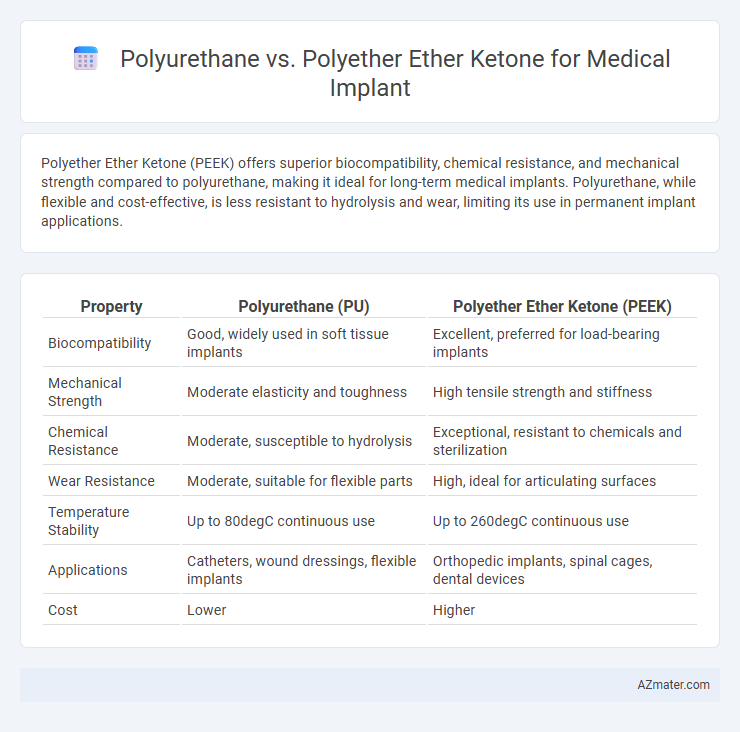Polyether Ether Ketone (PEEK) offers superior biocompatibility, chemical resistance, and mechanical strength compared to polyurethane, making it ideal for long-term medical implants. Polyurethane, while flexible and cost-effective, is less resistant to hydrolysis and wear, limiting its use in permanent implant applications.
Table of Comparison
| Property | Polyurethane (PU) | Polyether Ether Ketone (PEEK) |
|---|---|---|
| Biocompatibility | Good, widely used in soft tissue implants | Excellent, preferred for load-bearing implants |
| Mechanical Strength | Moderate elasticity and toughness | High tensile strength and stiffness |
| Chemical Resistance | Moderate, susceptible to hydrolysis | Exceptional, resistant to chemicals and sterilization |
| Wear Resistance | Moderate, suitable for flexible parts | High, ideal for articulating surfaces |
| Temperature Stability | Up to 80degC continuous use | Up to 260degC continuous use |
| Applications | Catheters, wound dressings, flexible implants | Orthopedic implants, spinal cages, dental devices |
| Cost | Lower | Higher |
Introduction to Medical Implant Materials
Medical implant materials such as polyurethane and polyether ether ketone (PEEK) are pivotal in advancing biocompatibility and mechanical performance. Polyurethane offers flexibility and excellent elastomeric properties ideal for soft tissue applications, while PEEK provides superior chemical resistance, mechanical strength, and radiolucency useful in load-bearing implants. Selection depends on specific implant requirements, balancing factors like durability, bio-inertness, and interaction with biological tissues.
Overview of Polyurethane in Medical Applications
Polyurethane in medical applications is widely used due to its excellent biocompatibility, flexibility, and durability, making it ideal for soft tissue implants, catheters, and wound dressings. Its resistance to hydrolysis and oxidation ensures longevity inside the body, while its customizable mechanical properties allow for tailored performance in various implant environments. Polyurethane's ability to be processed into films, foams, and elastomers supports diverse medical device designs and enhances patient comfort.
Understanding Polyether Ether Ketone (PEEK)
Polyether Ether Ketone (PEEK) is a high-performance thermoplastic known for its exceptional mechanical strength, chemical resistance, and biocompatibility, making it ideal for medical implants such as spinal cages and joint replacements. Unlike polyurethane, PEEK maintains dimensional stability under sterilization processes and long-term bodily exposure without degrading. Its radiolucency allows for clear imaging post-implantation, facilitating non-invasive monitoring and improving patient outcomes.
Biocompatibility: Polyurethane vs PEEK
Polyurethane exhibits excellent flexibility and durability with moderate biocompatibility, often used in soft tissue implants due to its elastomeric properties and relatively low inflammatory response. Polyether Ether Ketone (PEEK) offers superior biocompatibility characterized by excellent chemical resistance, mechanical strength, and minimal cytotoxicity, making it ideal for bone implants and long-term surgical applications. In medical implant design, PEEK's bioinertness and stability under physiological conditions provide a significant advantage over polyurethane for load-bearing and permanent implants.
Mechanical Properties and Durability Comparison
Polyether ether ketone (PEEK) exhibits superior mechanical strength and long-term durability compared to polyurethane, making it ideal for load-bearing medical implants due to its high tensile strength (approximately 90-100 MPa) and excellent fatigue resistance. Polyurethane offers flexibility and excellent elasticity but generally has lower tensile strength (around 30-50 MPa) and is more susceptible to hydrolytic degradation, limiting its longevity in biological environments. PEEK's resistance to chemical and thermal degradation ensures consistent performance in implant applications, while polyurethane's mechanical properties may diminish over time under physiological conditions.
Resistance to Chemicals and Sterilization
Polyether ether ketone (PEEK) exhibits superior chemical resistance compared to polyurethane, making it highly durable against aggressive sterilization processes such as autoclaving, gamma radiation, and ethylene oxide exposure commonly used in medical implants. Polyurethane tends to degrade or swell when exposed to harsh chemicals and prolonged sterilization cycles, which can compromise implant integrity over time. The robust molecular structure of PEEK ensures sustained mechanical performance and biocompatibility under repeated sterilization, making it the preferred choice for long-term implant applications requiring chemical inertness.
Long-Term Performance in the Human Body
Polyether ether ketone (PEEK) exhibits superior long-term performance in medical implants due to its exceptional biocompatibility, chemical resistance, and mechanical stability under physiological conditions. Polyurethane, while offering excellent elasticity and initial biocompatibility, can degrade over time through hydrolysis and enzymatic attack, leading to compromised implant integrity. The inert nature of PEEK ensures minimal inflammatory response and sustained functionality, making it more suitable for permanent implants requiring durability beyond several years.
Cost-Effectiveness and Availability
Polyurethane offers a cost-effective solution for medical implants due to its lower raw material and processing expenses compared to Polyether Ether Ketone (PEEK), which has a significantly higher cost driven by its complex synthesis and high-performance properties. While PEEK provides superior chemical resistance and mechanical strength appealing for long-term implant applications, its limited availability in varied forms can constrain manufacturing flexibility and increase lead times. Polyurethane's widespread availability and ease of fabrication enhance its cost-effectiveness for short to medium-term medical implants, balancing performance with economic feasibility in clinical settings.
Clinical Applications: Polyurethane vs PEEK
Polyurethane offers superior flexibility and biocompatibility, making it ideal for soft tissue implants, catheters, and cardiovascular devices where elasticity and patient comfort are crucial. Polyether Ether Ketone (PEEK) excels in orthopedic and spinal implants due to its high mechanical strength, chemical resistance, and MRI compatibility, supporting long-term structural stability. Clinical applications favor polyurethane in dynamic environments requiring elasticity, whereas PEEK is preferred for load-bearing implants requiring durability and stiffness.
Future Trends in Implant Material Innovation
Polyether Ether Ketone (PEEK) is gaining prominence in medical implants due to its superior biocompatibility, chemical resistance, and mechanical strength compared to traditional polyurethane materials. Future trends in implant material innovation emphasize the development of hybrid composites combining PEEK with bioactive coatings to enhance osseointegration and reduce infection risk. Advances in additive manufacturing techniques are enabling precise customization of PEEK-based implants, promoting personalized medicine and improved patient outcomes.

Infographic: Polyurethane vs Polyether Ether Ketone for Medical Implant
 azmater.com
azmater.com